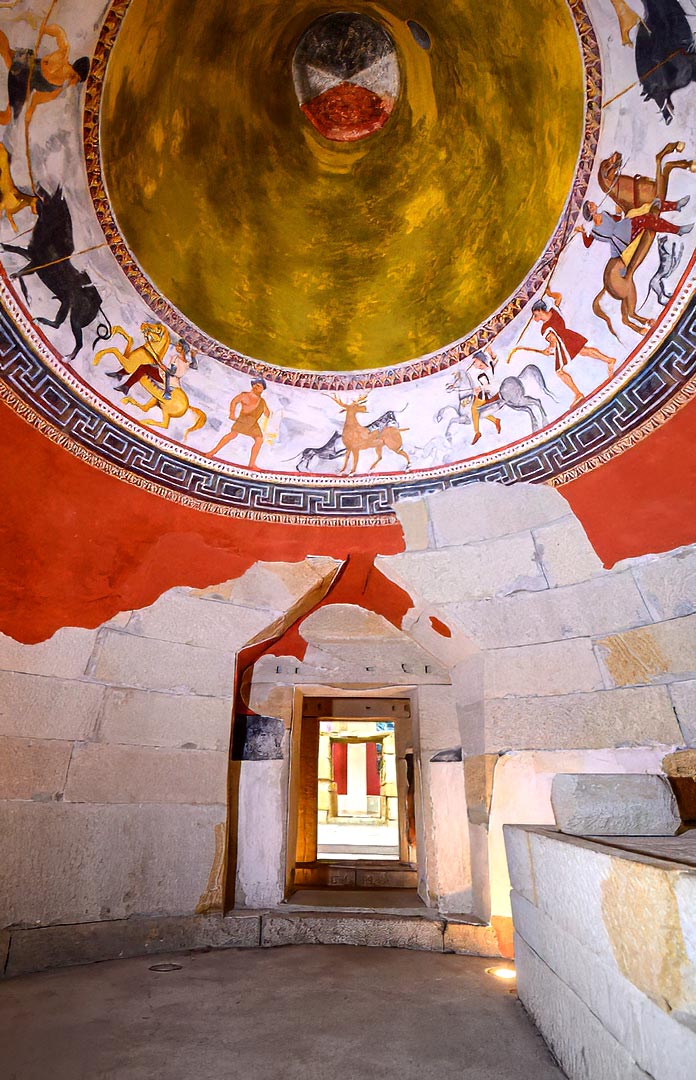A Discovery Written in Colors and Stone
In 2000, archaeologists uncovered the Thracian Tomb of Aleksandrovo inside a large burial mound near the village of Aleksandrovo, Haskovo Province. Dating back to the 4th century BC, this monumental tomb preserves an extraordinary fresco cycle, a painted narrative encircling the domed chamber with scenes of hunting, feasting, and heroic deeds.
The paintings are among the most detailed surviving depictions of Thracian life. Riders chase deer and boar; warriors carry double-edged swords and curved bows; athletic figures engage in ritual activities. The vibrancy of these images offers scholars invaluable insight into Thracian clothing, weaponry, and ceremonial practices.
Architecture with a Purpose
The tomb consists of a long corridor (dromos) leading to a circular burial chamber. The architecture—built from precisely cut stone blocks—echoes other monumental Thracian tombs, such as:
- The Kazanlak Tomb (UNESCO World Heritage Site) features an iconic horseman fresco and a banquet scene.
- The Sveshtari Tomb (UNESCO World Heritage Site) is known for its caryatid-like female figures carved in relief.
- The Tomb of Seuthes III at Golyama Kosmatka is a blend of temple and burial space with rich grave goods.
Each site, including Aleksandrovo, reflects the Thracian belief in the afterlife as a continuation of earthly status and power. The combination of architecture and art served not only as a resting place for a ruler or nobleman but also as a symbolic “house of eternity.”
The Aleksandrovo Frescoes: A Living Chronicle
What sets Aleksandrovo apart is the narrative richness of its paintings. Unlike the more symbolic decoration of the Kazanlak Tomb, Aleksandrovo’s art is almost documentary—showing active movement, expressive gestures, and a detailed portrayal of everyday and ceremonial life.
The hunting scenes, with dynamic poses and fine anatomical detail, may symbolize both the status of the deceased and the Thracian warrior ethos. Scholars also suggest a ritual dimension—linking the hunt to the soul’s journey and the ruler’s eternal guardianship of his people.
From Discovery to Preservation
Due to the tomb’s fragility, the original site is closed to the public to prevent damage from light and humidity. Instead, visitors can experience it at the Museum Center “Thracian Art in the Eastern Rhodopes” in Aleksandrovo village. Here, a full-scale replica recreates the tomb’s interior, allowing visitors to stand beneath the painted dome and walk through the dromos just as it was over 2,300 years ago.
The Broader Thracian Heritage
The Thracian Tomb of Aleksandrovo is part of a rich network of burial mounds across Bulgaria—archaeologists estimate there are over 60,000 Thracian tumuli in the country, though only a fraction have been excavated. Together, they form one of Europe’s most remarkable ancient landscapes.
Bulgaria’s most notable Thracian tombs include:
- Kazanlak Tomb (UNESCO): Late 4th–early 3rd century BCE; celebrated for its banquet and chariot frescoes.
- Sveshtari Tomb (UNESCO): 3rd century BCE; famous for unique relief figures blending Thracian and Hellenistic styles.
- Starosel Tomb Complex: Monumental stonework and ritual sites in the Sredna Gora Mountains.
- Golyama Kosmatka: Believed to be the tomb of King Seuthes III, containing rich gold and bronze artifacts.
Each of these sites, like Aleksandrovo, deepens our understanding of Thracian culture—its warrior aristocracy, artistic sophistication, and spiritual worldview.
Visiting the Aleksandrovo Tomb Replica
Location: Museum Center “Thracian Art in the Eastern Rhodopes,” Aleksandrovo, Haskovo Province.
Opening Hours: Usually 9:00–17:00; closed on certain holidays.
Entry Fee: Modest; guided tours available in Bulgarian and English.
Tip: Combine your visit with nearby attractions in the Eastern Rhodopes, such as Perperikon, Tatul Sanctuary, and Mezek Fortress, for a full Thracian heritage tour.
Why Aleksandrovo Matters
The Thracian Tomb of Aleksandrovo stands out as a visual history book—its walls alive with scenes that bridge the gap between archaeology and lived experience. It is a reminder that Bulgaria’s ancient past is not only a matter of stones and artifacts, but of stories, identities, and visions of life beyond death.
Photo by mitzo_bs



